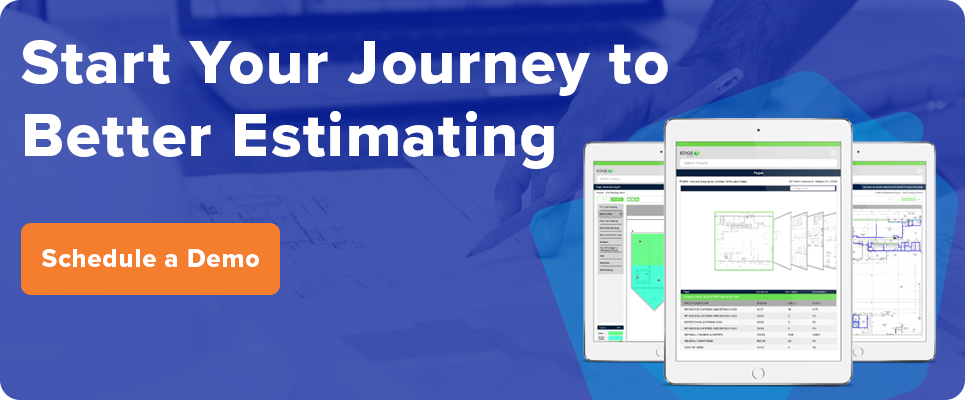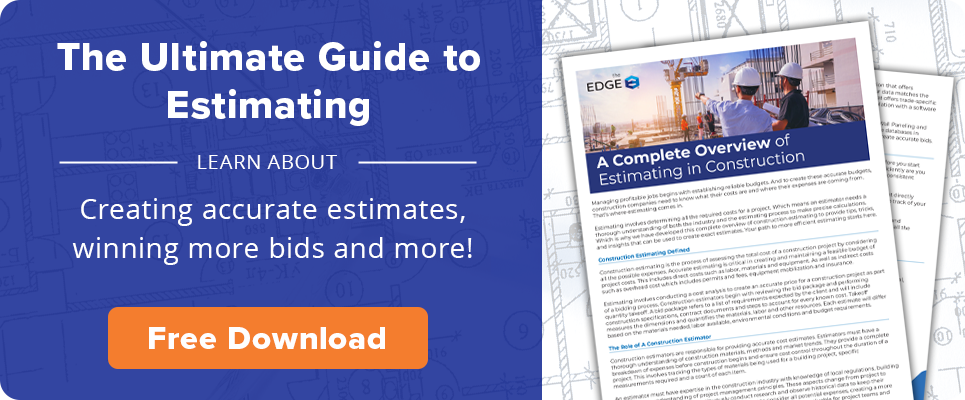
Understanding the value of construction cost estimating is key to achieving profitable construction jobs.
By creating a reliable budget based on costs and expenses, contractors can anticipate and plan for better financial success.
If a company does not have at least an initial view of their project costs, it can be very challenging to stay on budget or even complete a project at all.

A three-year study found that “only about 31% of all construction projects actually came within 10% of their budget.”[1]
This shows just how difficult it can be to manage cost estimating and how vital it is to get it right.
Estimating for construction involves an in-depth look at all project-related costs. This includes:
- Direct costs (labor, materials, and equipment).
- Indirect costs (overhead costs, equipment mobilization, and insurance).
It is up to the estimator to consider and calculate all these expenses for any given project, helping to create an accurate budget plan.
Therefore, it is important for professional construction estimators to have a thorough understanding of the estimating process and the nature of the industry, such as material specifications, techniques, and pricing.
Having precise construction estimating also helps a construction company stay competitive, as they can leverage bids or avoid overly expensive projects.
Once a company understands the value of construction cost estimating, the benefits will become apparent, with a company saving valuable time, money, and labor costs.
Construction Cost Estimators’ Guide: 5 Essential Takeaways for Detailed Bidding
- Construction cost estimation is crucial for project success, with accurate estimates serving as the foundation for financial planning and risk management in the construction process.
- Professional construction cost estimators must consider both direct costs (labor, materials, equipment) and overhead expenses to create comprehensive project estimates for various project types.
- The cost estimation process involves a detailed analysis of construction documents, site conditions, and current market rates to produce accurate bid estimates that help win profitable projects.
- Effective use of estimation software can significantly improve the accuracy and efficiency of construction cost estimating, helping manage complex calculations and changes in real time.
- Continuous improvement in cost estimating practices, including staying updated on labor rates, building costs, and industry market trends, allows construction companies to remain competitive and increase their project success rates.
What is Construction Cost Estimating?
As touched upon above, construction cost estimating is the recording and calculation of all costs related to a project, which is used to create detailed estimates to keep a company on budget.
Estimates can be broken down into (8) sections:
- Bid packaging: Estimators must review all client requirements and provide an overview of the project, evaluating all necessary preliminary items.
- Site visit: Estimators must then travel to and visit the project site, reviewing and considering the location and its conditions and searching for any environmental, local, or access limitations.
- Material takeoff: Quantities of materials will then be calculated, along with the cost of labor and equipment required to complete the project. Estimators must measure the count, length, area, and volume to calculate what materials are needed.
- Pricing: After determining what materials are needed, estimators will then solicit pricing from suppliers and vendors to create an accurate pricing framework.
- Labor: Determining the labor requirements for the project is necessary to stay on budget.
- An estimator must evaluate and budget for differing trade rates and past, as well as subcontractor costs, overtime, taxes, insurance, and union requirements (if applicable).
- Insurance and bonds: Although annual costs, estimators should still review and factor in insurance and bonds costs, covering the contractors and workers.
- Overhead and indirect costs: Although not always clearly visible in the bid package, overhead and indirect costs are important to calculate.
- Indirect costs may involve permits, temporary offices, site cleaning, or special software, while overhead may include utilities, taxes, rent, or insurance.
- Profit and contingency: Once all construction costs have been accounted for and calculated, the estimator will adjust to account for profit (the fee contractors earn) and contingency (about 5-10% of the project cost that is set aside for any unexpected waste).
These sections demonstrate the exhaustive nature of construction estimating, which has many moving parts and phases.
Why is Construction Cost Estimating Important?
Cost estimating is a vital way for construction companies to win lucrative jobs in this competitive commercial landscape because it really outlines the accurate and fair price of a project. (And with the detailed expense breakdowns, contractors can show owners why specific materials are priced at a certain amount).
Cost estimating offers numerous benefits that directly impact project outcomes. Accurate estimates enable better resource allocation, help in identifying potential risks early on, and provide a solid foundation for decision-making throughout the project lifecycle.
By establishing realistic budgets and timelines, cost estimating significantly increases the likelihood of delivering a successful construction project that meets both financial goals and client expectations.
On the other hand, cost estimating also reduces the dangers of taking on projects that will make no profit. If a project is looking to be way over the intended budget, a contractor can opt not to submit or retract the bid.
Additionally, construction cost estimating acts as risk management, helping:
- Identify potential threats to a budget, such as overruns and other financial risks
- Create contingency plans so that in the event of a financial emergency, there is a cushion reserved to soften the blow.
Most importantly, however, cost estimating is used to create accurate bids, allowing contractors to win jobs with precise, reasonable, and trustworthy numbers.
A poor estimating system could still result in overestimating or underestimating a project, negatively affecting a company’s profit.
So, it is important to ensure that cost estimating is being practiced effectively and accurately.
What Are The Challenges of Construction Cost Estimating?
In an industry where being accurate is key, cost estimating offers a set of unique challenges.
Firstly, when estimating, especially for material takeoff or quantity takeoff, it can be difficult to predict exact costs.
For example, during periods of unforeseen economic shifts, such as a recession, the cost of materials (lumber, bricks, steel, etc.) and equipment costs can fluctuate unpredictably.
This can make it difficult to be precise when estimating material costs or labor costs, especially when working on larger projects.
Bidding on and winning a new construction project is already a complicated process, but the work itself can be made far more complex the larger these projects become.
Contractors may find it challenging to manage multiple variables and stakeholders when estimating large projects, which often have many moving parts.
In addition, large or multisite projects may also need more regular updates and revisions, affected by anyone from the client or owner to the contractor and designers. This may lead to scope creep, where staying up to date with estimates is vital.
However, even on smaller, more manageable projects, communication between clients, projects managers, and designers can still lead to problems, as miscommunication or late responses can cause disputes or delays.
Finally, cost estimating is only as effective and powerful as the system it runs on. With technology advancing every day, the opportunity for tools, such as estimating software, can help enhance accuracy and streamline the process.
Companies that are wary of implementing new technologies may find themselves falling behind competitors with less precise estimates.
Who Uses Construction Cost Estimating?
Using accurate cost estimates is necessary for any company working in the commercial construction industry, working on any project, large or small.
Within a project scope there can be many individuals or groups using cost estimating. While there is typically a role assigned to a worker as an “estimator,” other individuals will have an impact on the estimating process.
This mainly includes:
- Contractors who work on bidding and securing potential projects and who will also work on managing the construction phases.
- Project managers will need detailed cost estimates, including overhead projections, to plan and execute the project schedule and budget, as well as monitor and manage resources.
- Architects and Engineers will determine if a project is financially feasible based on construction cost estimates. They may find ways to reduce costs within the design phase and align with the client’s budget.
- Clients and owners who establish a project budget and provide financing. Clients and owners need to know the expected costs to make informed decisions on the project, such as choosing a contractor.
Additional third parties, such as financial lenders, government agencies, or insurance companies, may also play a role in the estimating process.
As you can see, cost estimating is widely used in the construction industry as an extremely important portion of any given project.
Experienced cost estimators must have a thorough understanding of construction specifications, as these detailed documents provide crucial information about materials, quality standards, and installation methods, all of which directly influence the accuracy and comprehensiveness of the cost estimate.
So, it is vital for a company to be well-informed on the estimating process, utilizing any advantage possible.
How Does Cost Estimating Software Simplify Estimating?
While there may be many challenges that come with completing cost estimating, technology, and construction estimating software can help reduce these pitfalls.
Many estimating software programs offer automated calculations, which not only streamline the estimating process but also keep and record data accurately.
If there are changes to an estimate, estimating software provides change order management to quickly track, address, and implement changes.
Additionally, using estimating software, contractors can easily compare and contrast supplier pricing for cost-saving decisions.
Resources can be managed more efficiently, with communication organized into a central system, often reducing the chance of costly miscommunication between parties.
With the introduction of AI, estimating data can be analyzed and reported quickly and in detail, helping companies plan for the future or make necessary changes.
Some other benefits offered by software providers may include:
- Cloud-based access
- Trade-specific databases
- Training courses
- Scalable/ customizable systems
- Contingency planning
- Compatibility and integration with other systems
- Takeoff-specific tools
Any company can gain a competitive advantage simply by utilizing cost estimating software.
Modern estimator software not only streamlines the process to estimate costs more efficiently but also significantly enhances the accuracy of cost estimates by reducing human error, automating complex calculations, and providing up-to-date pricing information.
Even with the most complex project lifecycles, cost estimating software can make the process simple, protecting a company against unprofitable mistakes.
How Can The EDGE® Improve Cost Estimating?
Cost estimating is a critical aspect of all construction projects, used to determine if a project is financially viable and how it can be planned.
By assessing all direct and indirect costs related to a current project, estimators can calculate a budget and determine where and how resources should be used.
Accurate cost estimation is so important because it ensures that projects are financially profitable for a construction company and on budget for clients.
Even though estimating involves so many details and moving parts, projects may run into some challenges, including inaccuracies or miscommunications.
However, with the aid of advanced technology, tools such as estimating software can help mitigate many difficulties within the construction estimating process.

Estimating software offers invaluable features, such as built-in takeoff and resource management, which can mean the difference between a profitable, client-trusted company and one that drags behind in the industry.
If cost-estimating software can help benefit your company, Estimating Edge offers industry-leading all-in-one commercial construction software called The EDGE, which is designed and supported to keep construction companies successful.
To learn more, talk to a specialist or book a demo today!
[1] Propeller Aero. 10 Construction Project Cost Overrun Statistics You Need to Hear. Propeller. https://www.propelleraero.com/blog/10-construction-project-cost-overrun-statistics-you-need-to-hear/





